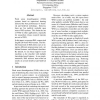23 search results - page 1 / 5 » Word Sense Disambiguation using Static and Dynamic Sense Vec... |
100
click to vote
COLING
2002
14 years 12 months ago
2002
It is popular in WSD to use contextual information in training sense tagged data. Co-occurring words within a limited window-sized context support one sense among the semantically...
ACL
2010
14 years 10 months ago
2010
Word sense disambiguation (WSD) systems based on supervised learning achieved the best performance in SensEval and SemEval workshops. However, there are few publicly available ope...
CICLING
2006
Springer
15 years 3 months ago
2006
Springer
The disambiguation of verbs is usually considered to be more difficult with respect to other part-of-speech categories. This is due both to the high polysemy of verbs compared with...
119
click to vote
NLDB
2007
Springer
15 years 6 months ago
2007
Springer
Word sense disambiguation is the task to identify the intended meaning of an ambiguous word in a certain context, one of the central problems in natural language processing. This p...
111
click to vote
CORR
2004
Springer
14 years 12 months ago
2004
Springer
This paper describes the National Research Council (NRC) Word Sense Disambiguation (WSD) system, as applied to the English Lexical Sample (ELS) task in Senseval-3. The NRC system ...


